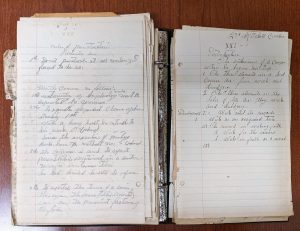I was hired as the Justice, Equality, Community (JEC) Project Archivist as part of the campus-wide Justice, Equality, Community (JEC) grant initiative at Davidson College in August 2017. The 3.5 year JEC grant aimed to “reimagine humanities curricula through the lens of three ideas that cut across cultures, time, and disciplines: justice, equality, and community…to demonstrate the critical role of humanistic inquiry in public discourse, global problem-solving, engaged citizenship, and democratic leadership.”
To accomplish these lofty goals, the initiative included funding for research partnerships between faculty and students, a series of practitioner-in-residences, community-minded experiential learning projects, and archival collecting and digitization efforts centered on questions about race and religion in the greater-Davidson area. As the JEC Project Archivist, I was responsible for the following tasks in support of the grant’s archival component:
- Identifying and digitizing JEC collections.
- Integrating JEC materials into at least 5 new courses.
- Expanding archival collections related to JEC.
- Leading public programming about JEC materials, both on campus and in the larger community.

Let’s take a look at how we faired with these four goals and the work that remains. In the last three years, we have digitized:
- over three dozen oral histories,
- the 19th century faculty minutes and trustee minutes Davidson College, as well as the nineteenth century Davidson College Presbyterian Church minutes,
- the 20th century faculty minutes of Davidson College,
- the records of the Davidson, NC Community Relations Committee,
- the records the Black Student Coalition,
- the Arabic Bible of Omar ibn Sayyid (now on display at the National Museum of African American History and Culture)
- relevant selections from the Davidson College Chaplain’s Office Record Group,
- materials from the Chalmers Gaston Davidson Plantation Files collection,
- and our latest, “coming soon” addition: the complete runs of the Davidson Monthly and Davidson Journal.

We incorporated these digitized materials into at least two dozen course sessions, outreach programs like “An Evening with…” and multiple presentations to local historical societies. The collections were also used to support some of the research efforts of the Davidson College Commission on Race and Slavery. We then used the student work collections as examples when speaking to student activists and leaders about the importance of saving their records and establishing dialogues to help us learn how to more equitably and respectfully do that work through the JEC Student and Alumni Advisory Council.

These class sessions and outreach initiatives led to several multi-year course collaborations that resulted in donations to the archives in some cases and high-profile projects in others. For example, the hard work of Dr. Jane Mangan’s HIS 259: Latinos in the United States course resulted in nearly two dozen oral history interviews documenting the Latinx experience of Davidson (now viewable, here). Another oft cited project is Disorienting Davidson, a multi-year student-led project that informed the senior thesis work of H.D. Mellin ’20. Mellin utilized many of the collections later made digitally available by JEC grant funds over the course of several semesters for this groundbreaking student project. Their work also helped archivists identify highly sought-after collections that informed the digitization selection process.
While collaborations within the department and across teams have led to significant strides in terms of access to archival collections and course collaborations, much work remains in terms of community outreach and collections development around the issues of justice, equality, and community. In recognition of that need, the Justice, Equality, Community Archivist position was made permanent at Davidson College in March 2021.
To access the digitized collections mentioned in this blog post, please email archives@davidson.edu.
Related Posts:
- Digitization Projects: Community Change and Oral Histories, Part 1
- Digitization Projects: Community Change and Oral Histories, Part 2
- Justice, Equality, Community (JEC) Student and Alumni Advisory Council
- The Davidson College Task Force on Racial and Ethnic Concerns, 1984
- Justice, Equality, and Community Archivist Is In The Library!



























